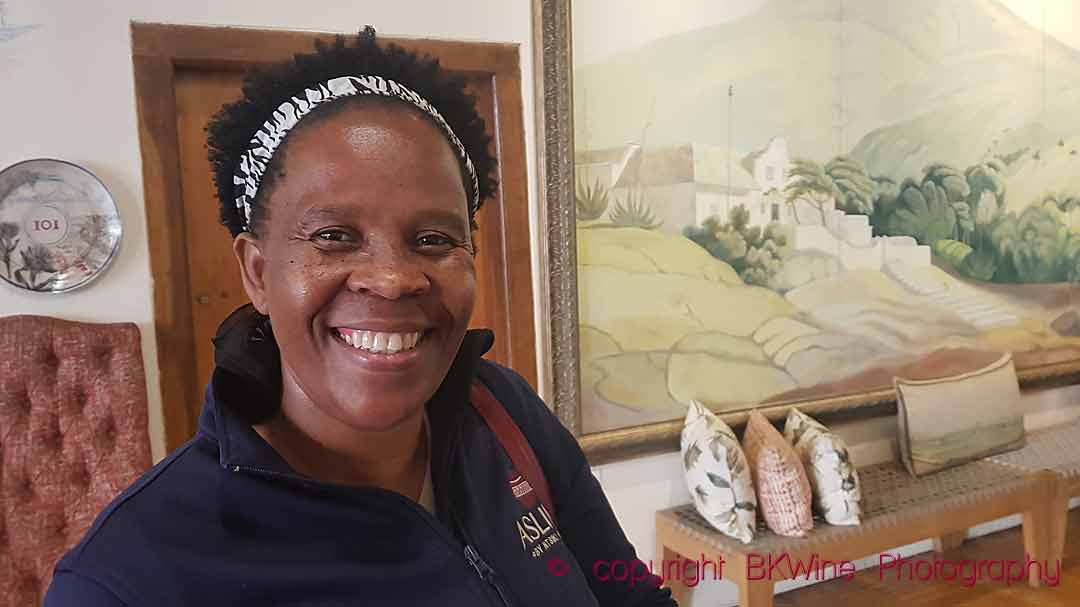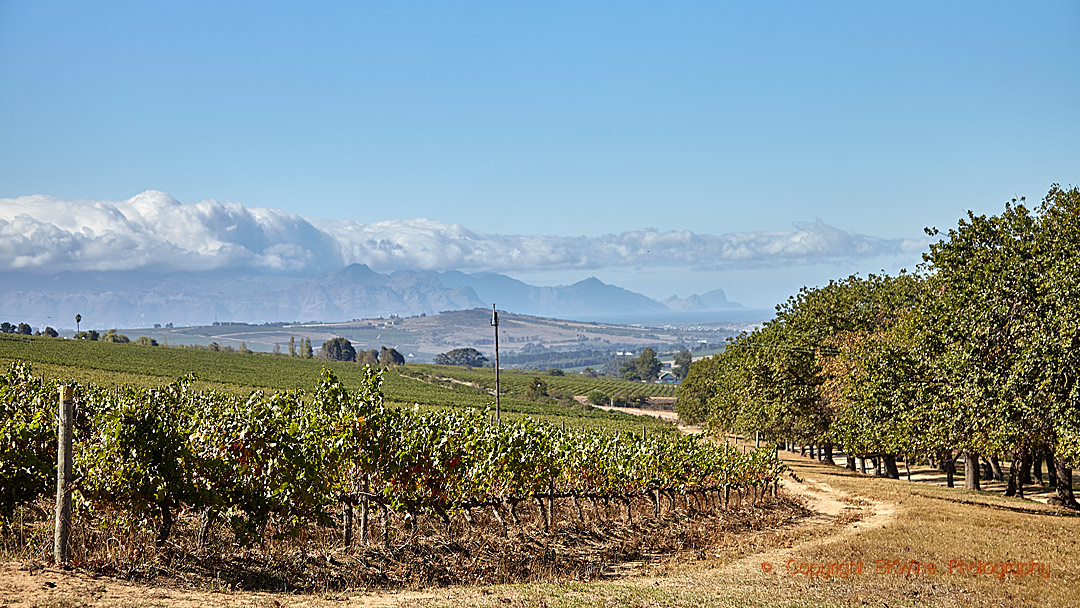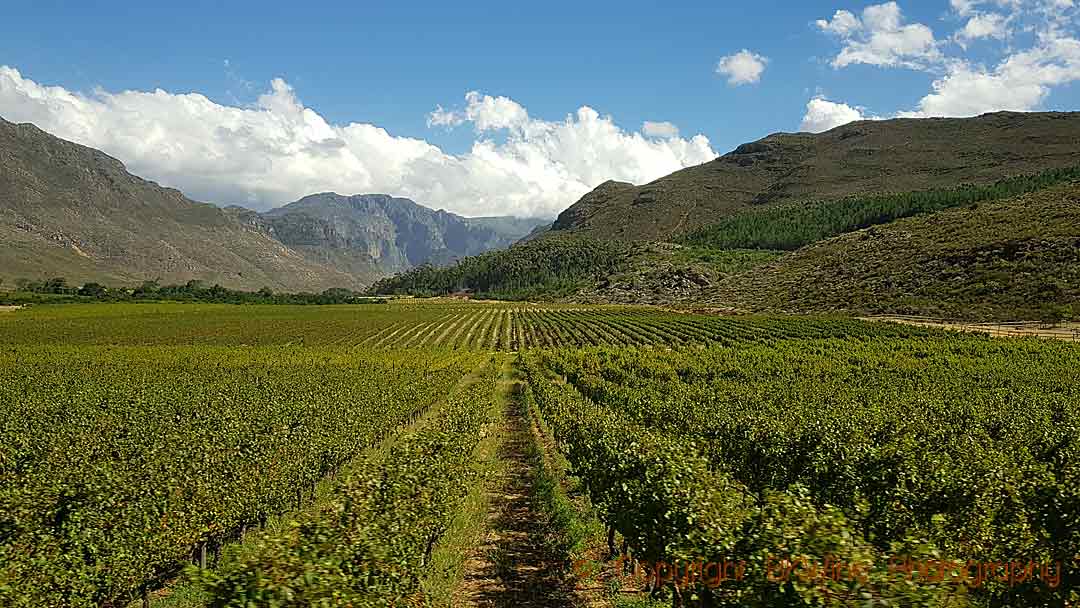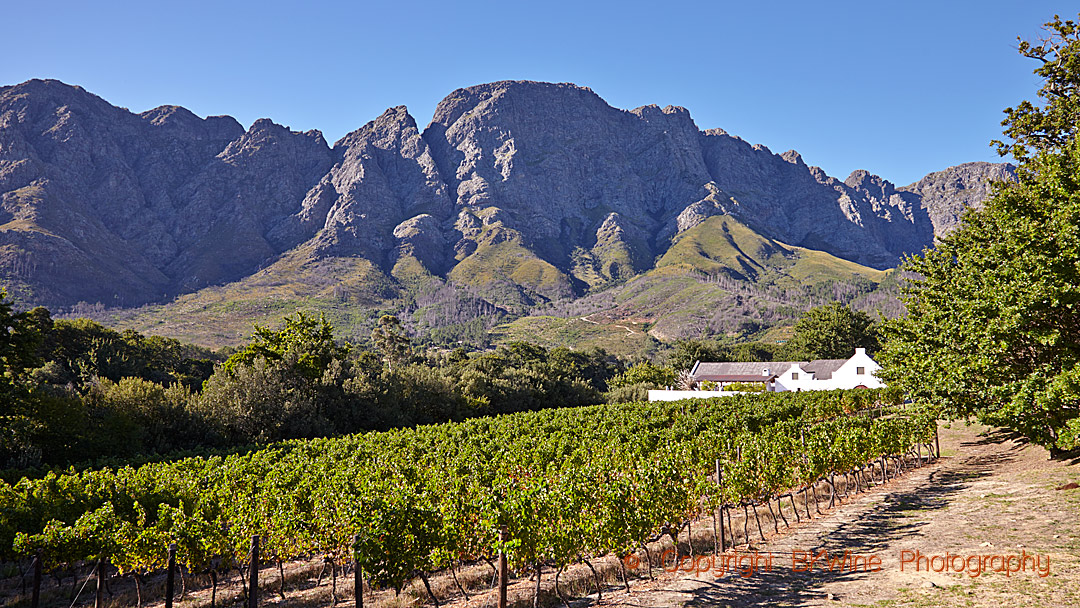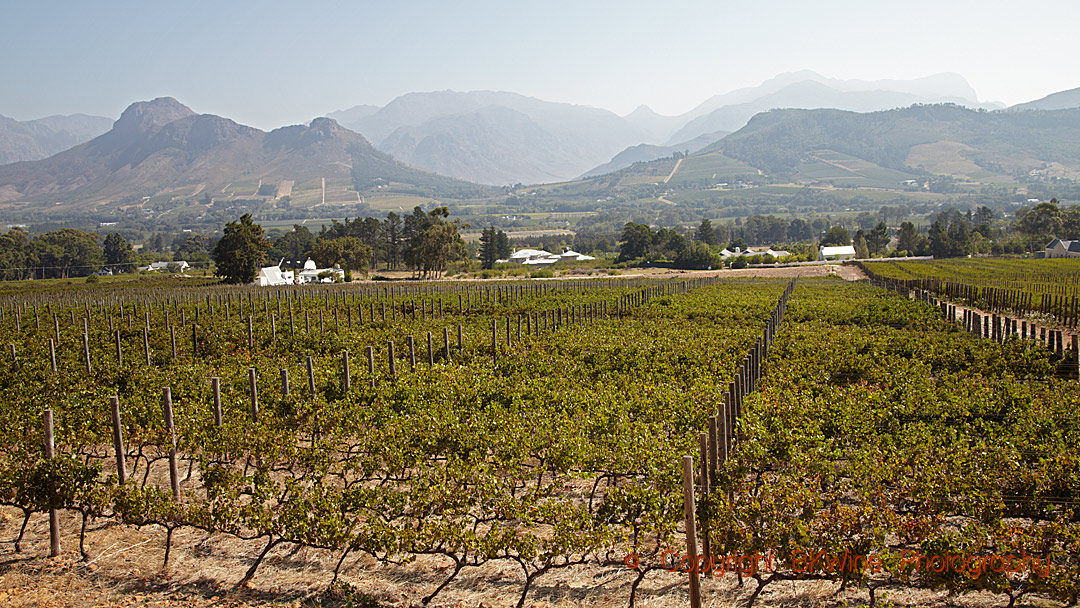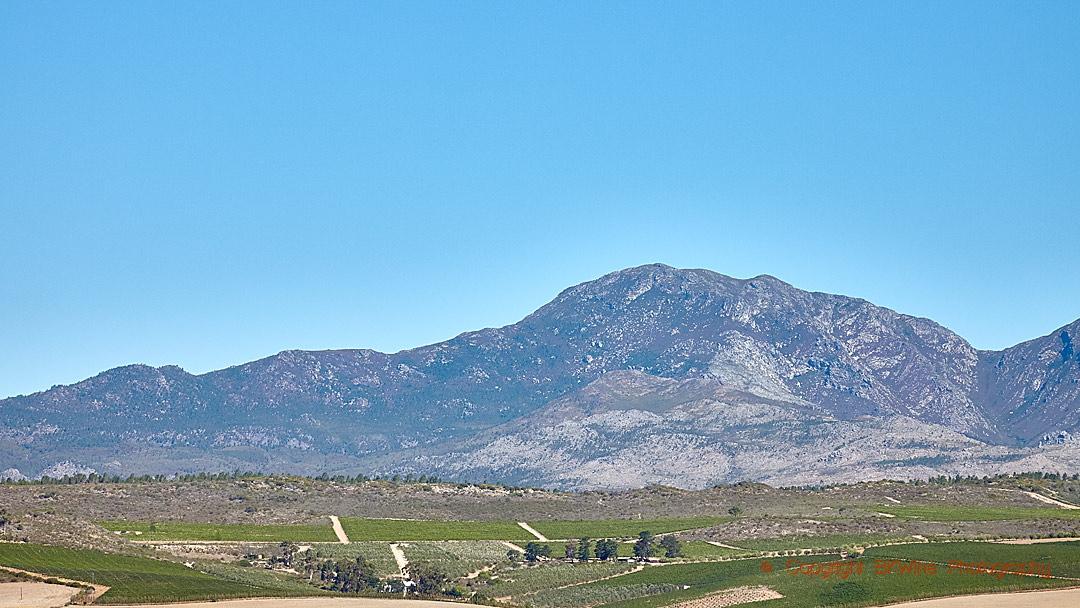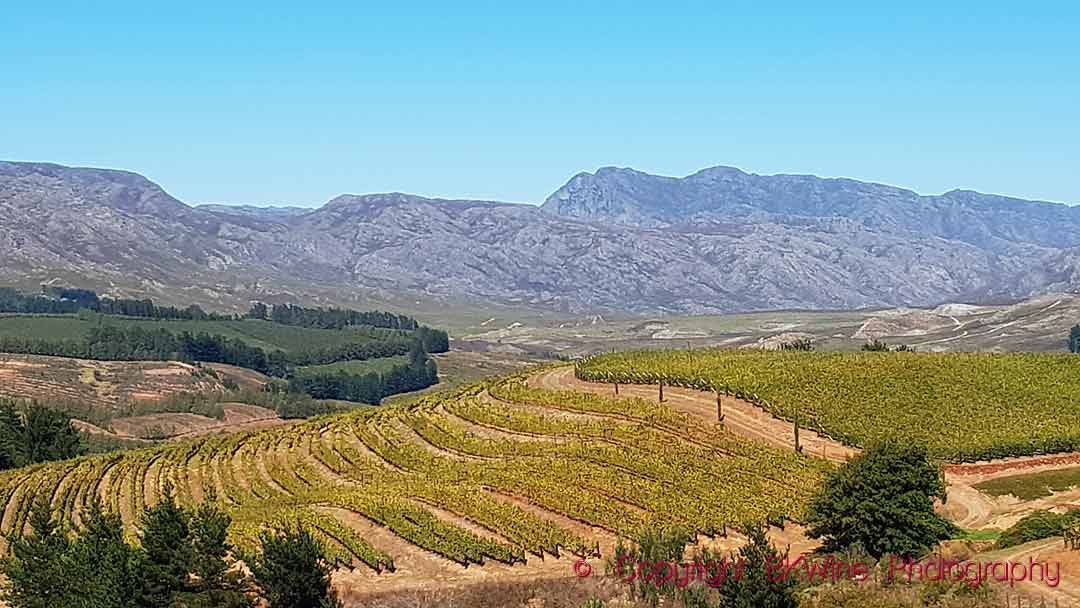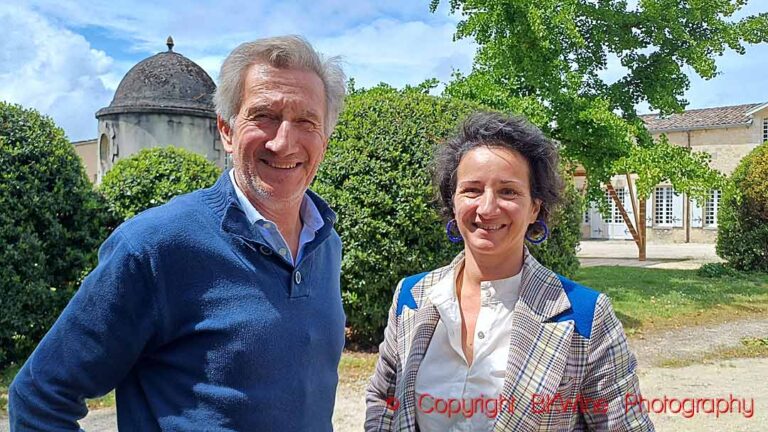“If they can do it, perhaps I can too,” she thought at an African Women’s Entrepreneurship Conference in 2014. That was the spark that made Ntsiki Biyela decide to launch her own winery, called Aslina Wines. Ntsiki was already famous as the first black woman winemaker in South Africa, making excellent wines for the Stellekaya Winery. Why would she jump out into the unknown in a challenging market and create her own winery? Read this fascinating story about someone in the new generation of ambitious winemakers in South Africa, and you’ll find out. And you’ll find out who “they” were and why she chose the name “Aslina”. As a bonus, you’ll get some insight into what the South African wine industry needs to do next to succeed going forward.
I met Ntsiki Biyela for the first time thirteen years ago, on our very first wine tour to South Africa. At the time, she was working as a winemaker at Stellekaya in Stellenbosch. She had already made quite a name for herself, even featuring in a CNN video (as well as on a BKWine video!). She comes from KwaZulu-Natal. There are no grapes there, so they make no wine. Ntsiki won a scholarship to study at university. She decided to study winemaking at Stellenbosch University. One can wonder why. She had never tasted wine. (You can read more on what Ntsiki had done previously in the articles referenced at the bottom of this text.)
This is a longer version of an article published on Forbes.com.
An article in our series of talks with South African winemakers. Read all here:
- Springfontein Wines, surprising and extraordinary South African
- Hidden high up in the Stellenbosch mountains is a gem, Oldenburg Vineyards
- Kaapzicht, a pinotage pioneer and cabernet champion in Stellenbosch
- Both classic and unusual, Stark-Condé Wines in Stellenbosch, South Africa
- Aslina Wines, Ntsiki Biyela’s new venture, and the future of South African wine
- DP Burger at Glenwood Vineyards in Franschhoek, South Africa
And also:
Her studies went well, and when she was recruited by the Stellekaya winery, she became the first black woman winemaker in South Africa. (There still aren’t that many.)
And then I lost touch with Ntsiki. Even though I came back to South Africa almost every year, I never really had the opportunity to reconnect. Until recently.
A little while back, I did have the opportunity to meet Ntsiki again. I was in South Africa tasting and judging in the Michelangelo Wine Awards competition, which an eagle-eyed Swedish importer had spotted, Brett Adam, at Cape Wine Experience. Brett was about to launch one of Ntsiki’s wines in the Systembolaget monopoly shops in Sweden. (Or, to put it another way, he had won the “lottery” of being selected in one of Systembolaget’s tenders. However, considering the quality of Ntsiki’s wines, perhaps it was not as much of a lottery as it sometimes is.)
I had seen from a distance some of what had happened, that Ntsiki had left Stellekaya and started her own winery, but I had not had the opportunity to taste her wines. So I jumped on the chance to meet her again in Stellenbosch.
The Aslina story
So here’s the story.
Ntsiki left Stellekaya in 2015 but already in 2011 she had asked her then-boss at Stellekaya if she could launch her own brand “on the side” while being winemaker at Stellekaya. That was okay, so she started to make small quantities of wine on her own. She then happened to meet an American woman named Mika Bulmash. Today, Bulmash runs a wine-importing company in New York (Wine for the World) , but at the time, Bulmash was not then in the wine industry. But she had an idea for an unusual wine project. She wanted to set up a collaboration between a winemaker in California and a winemaker from South Africa to make a wine together. Ntsiki jumped on the idea and started making wine together with Helen Keplinger in Napa Valley.
While still at Stellekaya, Ntsiki made a wine together with Helen Keplinger in the Western Cape region in South Africa, and Mika Bulmash imported it to the US in 2014. The collaboration continued in 2015 when they made 1800 bottles. This was a Ntsiki-Helen co-branded wine that was Ntsiki’s first step towards becoming independent. Then things slowly, slowly took off, although she had not yet started her own business. The independent winemaking project with Keplinger was just a one-off, and she was still working for Stellekaya.
Note: as Ntsiki does not have her own vineyard or own cellar, many of the illustrations are from other South African wineries.
African Women’s Entrepreneurship Program
“In 2015, I was invited by the US State Department to an African Women’s Entrepreneurship Program,” says Ntsiki. On the program, she met women from different African countries involved in varying entrepreneurship projects, Kenya, Zimbabwe, Nigeria, the Gambia, and Malawi. She was the only one working with wine. The discussions with these other African entrepreneurs make her think about her own situation. When she met these other African women, she told me she remembered thinking, “they are running successful businesses, and then they talk about the struggle they have in their countries, like, for instance, they can’t get a loan from the bank because they are women, or others could not register their company in their own name but had to register it in the name of their husband or their son….” Getting financing is a challenge for any entrepreneur in many countries in sub-Saharan Africa, and even more so for women entrepreneurs who face a number of additional obstacles. Ntsiki continued on her thoughts at the meeting with these other African women: “So why am I not starting my own company? In South Africa, I can register a company under my own name. I can get a loan from a bank.”
But that was not the only eye-opening thought that came up during this conference. Ntsiki invited the women to her room to have a chat and a drink. She was a winemaker so why not show it? “Why are you on drugs?” they asked her when she brought out a bottle of wine. “Drugs? Hey, I’m not on drugs,” she said with fear on her face, “unless you’re saying wine is a drug. But it’s not a drug, you know. It depends on how you drink it.” And then the important and life-changing question came up from the other women in the room: “Why haven’t you started your own company?” they asked. One shock after the other.
When she came back to South Africa after the conference, she resigned from Stellekaya. Which was not taken well by her mentor in the UK, “How can you resign just like that from your job?” But the three weeks program with the other African Entrepreneurs had given Ntsiki the momentum she needed. “If I don’t do it now, I’ll never do it!” she said. She stayed at Stellekaya for another few months to do the 2016 harvest and finally left the company in June 2016.
That’s when she launched Aslina Wines, Ntsiki Biyela’s own personal brand of wines.
She got back in touch with her importer in the US, Mika Bulmash, who had initiated the collaboration that resulted in the Biyela-Kepler wine a couple of years earlier. Her first reaction was, “well, Ntsiki, I cannot buy enough wines from you for you to make a living.” A cold shower, perhaps, but Ntsiki did not seem too worried. “Let’s just see how it’s going to go,” she said. “Part of me knew it’s going to work. I didn’t have the muscle for it to go fast, but I knew it was going to work.”
She had actually already made some wine independently (with the approval at that time of Stellekaya). She had made 4500 bottles of cabernet in 2014 and a blend in 2015, a total of some 7000 bottles.
How to start a winery
But how do you go about creating a winery, starting from scratch? You don’t have any vineyards, and you don’t have a winery. What do you do? You do what you can; there’s always a market. For her initial wines, Ntsiki bought both grapes that she vinified and also some “bulk” wine from other wineries (including Stellekaya). For space, she rented a small corner at Summerhill Wines, a winery just outside the town of Stellenbosch. (Stellekaya is in the town, but it is quite small, so I imagine they quite simply didn’t have any space to spare.)
So now Ntsiki had wines, and she needed to sell them. She got back in touch with Mika, her US importer. “Okay, I’ll buy some of your wines, but you’ll have to come to the US so we can sell it,” Mika responded. “Fine,” Ntsiki said, “as long as you’ve got a couch for me to sleep on”. She also had contact with another importer, one in Texas, who was less enthusiastic and not convinced that it would sell. But she managed to convince him to buy enough wine for Ntsiki to be able to buy a flight ticket to come to the US. And thus, the first 20 cases of Ntsiki’s wines travelled across the Atlantic. And she also left a little friendly note to the Texas importer saying, “you’re going to regret that you bought so little”. Maybe that’s the self-confidence you need when you jump out into the unknown.
Ntsiki’s first stop in the US was with the importer in Texas, of all places. Not exactly the wine capital of the US. The importer picked her up at the airport and told her that the first stop would be to someone he wanted to show Ntsikis wines to. He tasted the wines and said, “I’ll buy five cases”. Ntsiki quietly whispered in the ear of the importer, “now you’ve only got 15 cases left”. He squirmed and said, “uh, don’t say you told me so…” The next one they went to see bought another five cases, and after two days, there was nothing left of the twenty cases. But they still had more people to see and told everyone, “yes, it’s on its way; it’s on the ship”.
Ntsiki’s next stop was with Mika in New York, who had also bought twenty cases. Things went well there, too, so by the time Ntsiki was heading back to South Africa, a new shipment was already being prepared for New York and Texas.
“It was heart-warming. I was filled with gratitude when I left the US because of the acceptance of the wine. It was like ‘I have arrived.’ That’s how it all started.” And soon, other countries started asking for her wines, Germany, the Netherlands, Ghana, Japan, the UK, Sweden, Switzerland, Norway…
With time, Ntsiki hopes to have her own cellar and vineyards, but for the moment, she’s still renting space (but elsewhere now). She continues buying grapes and sometimes wine to create her blends. In most cases, the bought grapes come from specific vineyards that Ntsiki follows during the year so that she can be confident of the quality. Today she has a team of five or six people working with her.
She has reached a production of 100,000 bottles (corresponding to something like ten hectares) with a range that includes three whites and two reds. The first wine she made was a cabernet; then she made two sauvignon blancs, the red blend, followed by a chardonnay. Why those? Her very first business plan, written in 2008 (!), was with MCC (the sparkling “méthode cap classique”) and pinot noir. Looking back at that, she thought it was too much of a niche market – “you need to put food on the table”. But not only that. “I love cab. That’s what I’ve been working with”, she said, so that was the natural thing to start with, plus adding to that a red blend.
After the two reds, she wanted to add a chardonnay as a first white. But not owning any vineyards, you have to go out and buy the grapes for it. “There was a scarcity of chardonnay that year, so that I couldn’t get enough grapes. So instead, I started with sauvignon blanc.” The realities of making wine and running a business…
The wines from Aslina by Ntsiki Biyela
Most wines have the origin indicated as Western Cape.
Aslina Sauvignon Blanc 2021
~125 ZAR from the winery
The sauvignon blanc was intended as a once-off. But things didn’t go according to plan. It sold well in the US, so Ntsiki quickly ran out of stock (perhaps not difficult with 1000 bottles). Mika, her importer in New York, told her, “okay, it’s a once-off, but you need to come here and tell the distributors that it’s a once-off and that they can’t have any more”. What could Ntsiki do? “Okay… Fine…. I’ll continue with the sauvignon blanc.” It’s become a permanent part of the range. But she’s been struggling to get it to the style of wine she wants. Every time she tasted sauvignon blanc wines, she had difficulties with the short finish after all the excitement on the nose. Until she tasted one that had been aged on the lees, which kept its promise all through to the finish. Her sauvignon blanc thus became a lees-aged white. The first one she made, she kept on the lees for ten months, which gives a lot of mouthfeel and richness. But her current version has it shorter. “Getting to the market with a sauvignon blanc with ten months lees contact, you have to explain to people what it is. ‘Is it chardonnay?’ people ask. ‘No, it’s sauvignon with ten months on the lees.’ So I needed to reduce the time on the lees,” Ntsiki explains. She now keeps it for five months on the lees, which does not have quite as big an impact on the style. It’s on the fine still lees after fermentation, so not any battonage that might make it too solid. The grapes are not harvested particularly early, just “normal” at 22.5-23 balling (brix), which means approximately 13-13.5 % potential alcohol.
There were also customer expectations that a sauvignon blanc should be on the shop shelves shortly after the vintage. Perhaps that’s a pity? A full-bodied and rich sauvignon can be lovely. (Not that her current version isn’t.) Maybe we can hope for a second sauvignon blanc wine with much longer lees contact one day to be released from Aslina Wines?
A very herbal, typical sauvignon blanc with a lot of freshness and sprightly acidity, lots of grass and herbs, green vegetation, and nettles, but with an added twist of richness in the body. It’s more of a Sancerre type of sauvignon blanc, rather than a New World version, very aromatic and intense aromas. A typical classic sauvignon blanc. Ntsiki says about it, “every time I drink it, it takes me to a hot summer day when I am sitting under a tree looking at the sea”. Not bad for a wine then.
Aslina Chardonnay 2021
~150 ZAR from the winery
Ntsiki prefaces this wine with “this is primarily based on what I like myself. I used to taste and judge in competitions and was often impressed by the intense wooded chardonnays. But then when I drank that type of wine myself, I was struggling, couldn’t finish the glass. But when I then had an unwooded chardonnay, there was something missing. So I wanted to get something in the middle, blend the two.” She has experimented with different “recipes” for this, sourcing grapes from Paarl and Elgin, ageing in stainless or oak depending on the grapes. Now, she sources grapes from Stellenbosch and Elgin on the south coast. She has the Stellenbosch in stainless steel and the Elgin wine in barrels. Why so? “Stellenbosch is warmer so that the chardonnay is rich by nature. Elgin is more on the acidity and minerality. With a bit of wood, it will tone down this acidity a bit.” She struggles a bit with getting the fruit for this wine. Mostly she gets the grape from some of the big established producers, but some years it can be difficult. There’s not enough chardonnay fruit to buy. Chardonnay, of good quality, is actually scarce, she points out. So Ntsiki has not always managed to get enough fruit of good enough quality, limiting the production.
“In the wine, there’s a bit of wood character, but it’s at the back of it. This is the type of chardonnay I like,” she comments. And indeed, so it is. The wood is very discrete. The wine does not give the impression of being wooded, more on the exotic fruit side, typical chardonnay character. Elegant with some exotic fruit on the nose, but a bit shy, especially compared to the explosive sauvignon blanc. But it has more to give on the palate, good mouthfeel, lots of exotic fruit, some citrus, a very nice freshness, long refreshing finish.
Aslina Chenin Blanc 2021, skin contact
~205 ZAR from the winery
This is the new white in the range, introduced in 2021. Already when she was at Stellekaya, she was curious to see what she could do with skin contact with a white wine, although it never happened at the time, “I wanted to see what happens if you give white wine skink contact.” But why do it with chenin? “Chenin is a very versatile variety, so it will work well with anything I try to do,” was the simple answer.
Deciding to try a skink contact white, she managed to source chenin grapes from Delheim. The cellar-master there was a bit doubtful but still let her have the grapes. Ntsiki remembers, “when it came out, this is exactly what I imagined.” When told about the skin contact plans, her US importer thought Ntsiki was planning to make an orange wine. “No, I don’t want orange wine. I want chenin blanc crispy and clean. But with skin contact”. And indeed, it is in no way an extreme or even pronounced skin contact wine. It spent seven days macerating on the skins, off the skins even before fermentation was finished. “I made this for myself.” Curiously, South Africa is well-known for its chenin (it sometimes used to be called steen), but it seems not very appreciated in the country itself. Perhaps that has to do with that it has been used very much for brandy production, for which it is pushed to very high yields. Maybe that high-yielding tradition has led to too much diluted chenin blancs being made.
The Aslina skin contact chenin has a very discrete skin character, something that often shows in a certain astringency (tannins) and distinct dry mouthfeel. Here, the skin is discrete, a bit like the very discrete barrels on the chardonnay. It does bring out a little bit more of the chenin character and gives it a bit extra body with a touch of phenolics, a touch of tannin feeling. The nose is very clean with fresh citrusy notes that come back on the palate, with carambola and grapefruit. A long finish with elegant and refreshing tannins.
“That tannin feeling is exactly what I wanted in the wine,” says Ntsiki. Her team in the winery tries to make sure she is not left alone too close to the chenin bottles in the cellar. “I tell them I need to taste it again and again since it is a new release. I need to check how it develops. ‘But does it develop every day?’ they ask me.” It is obviously one of her favourites. And mine too, of the whites.
Aslina Cabernet Sauvignon 2020
~185 ZAR from the winery
It says cabernet sauvignon on the front label, but it actually has a small portion of petit verdot too. Well, small… 14%. There’s a story behind that dash of petit verdot. Ntsiki explains, “the way I used to make cab (at Stellekaya), I always added a little bit of something. For example, maybe I had a barrel of cabernet franc in the corner, and I’d chuck it in without much thought. When I started Aslina, I had this (mis)understanding of petit verdot; that it was just tannins and colour, that’s it. But I had just tasted a number of petit verdots, and some of them had beautiful fruit in them. So I became curious. So I did some experimental blends, one with petit verdot. I realised that the one with petit verdot made me want to chew on the wine. ‘Okay, I’m gonna keep on working with you,’ I told it.” The cabernet sauvignon grape is becoming one of the favourite varieties in Stellenbosch. It has adapted very well to the climate. This one has spent 14 months in oak, second and third fill barrels, no new oak. The cabernets come from the Helderberg area.
The Aslina Cabernet Sauvignon is very much in the style of a “classic” cabernet. It is not obviously barrel-aged, with very much fruit, and very nice ripe tannins, which you need in some of these quite powerful cabernet wines. The nose has an exuberant bouquet of black and red fruits and black currants.
Aslina Umsasane 2020
red blend, ~235 ZAR from the winery
Maybe this is Ntsiki’s most important cuvée, at least emotionally. Umsasane is the Zulu name for the umbrella tree, a type of acacia, a tree that is an African icon (not to be confused with the Australian umbrella tree). But more importantly, it is the nickname of Ntsiki’s grandmother, and her real name was Aslina. The meaning of Aslina is something like “woman of power” or “woman of strength”, which seems appropriate.
Why name the winery, and the wine, after her grandmother? When Ntsiki was young, she grew up in the care of her grandmother in the village where she was born. Her mother was working as a domestic worker for a family in Durban (the big city in KwaZulu Natal with 4 million inhabitants) and was, therefore, rarely at home, only twice a year. So the names are a tribute to the woman who taught her everything about life. “When I look back, I think, how did she do all that she did? Raising so many kids, with a pension of 420 rands a month, grandfather gone… How did she manage? Through all the difficulties, she was always the person everyone came to.”
Also, the label design (of all cuvées) is a reference to South African culture and history. The label is decorated with a calabash, a container – gourde – that was used to drink the traditional beer. Usually, it is made from clay but sometimes from a type of pumpkin. On the label it is filled with grapes.
The Umsasane wine is certainly a magnificent tribute to a remarkable woman.
This is the Bordeaux blend with cabernet sauvignon 70%, cabernet franc 28%, petit verdot 12%. Even though the blend is not very dissimilar from the cabernet sauvignon-wine, the character is very different. It has an intense nose with lots of dark fruit, quite complex with hints of chocolate (no doubt from the barrels). An excellent balance, strong but balanced tannins. The freshness gives it a little hint of cabernet franc character. It has also been aged in barrels, which is a little bit more noticeable here, but very balanced. The ripe fruit and the oak have given it a lovely structure with good ripe tannins in the finish. The grapes come from the Simonsberg area, which probably also contributes to the difference. Calling it powerful is not the right word because it certainly is not a “power” wine. But it has very intense fruit and aromas.
There is also a sixth cuvée in the range, but it is very rare.
Aslina Méthode Cap Classique (MCC) 2016
~410 ZAR from the winery
This was a project that Ntsiki created to honour and celebrate her mother. She has now passed away, but she did have the chance to taste the wine. At the very beginning, when Ntsiki started thinking of making her own wine, around 2008, méthode cap classique (MCC, the South African sparkling made with the “traditional” method with a second fermentation in bottle) was one of the wines she wanted to make. She has made only 600 bottles of it, and it is only available directly from the winery. This is partially due to the small quantity but also due to the price, or the production cost, which would make it a hard sell through traditional distribution channels. It’s from the 2016 vintage and was bottled in 2017. It spent around four years on the lees and was degorged in 2021.
The wine is available from the winery (and a very tiny quantity will go across the Atlantic to her US importer). But I did not have the opportunity to taste it. All the more reason to come back.
Going forward, for Aslina and for South Africa’s wine industry as a whole
What is then number seven on the list of Ntsiki’s projects? Well, it’s not a wine. Instead, she hopes to be able to find a place to open a tasting room and have her own cellar. Surely there will be a decent size garage available somewhere in Stellenbosch that can house 100,000 bottles and growing.
Ntsiki now has 18 years behind her, making wine in South Africa. What has changed in the South African wine business over these eighteen years?
I’ll let Ntsiki’s words speak for this:
“Winemakers are experimenting more. Winemakers have taken on board constructive criticism and feedback from, e.g., wine competitions. There’s a change in the quality of wine being produced. But outside of that, there is also the social aspect of it. Before, there were very few black people that you would see or meet in the industry, or when you walked into a wine shop that you’d see coming in to taste the wines. That has changed. Now when you go to a tasting room or a wine shop, you can see, “oh, yes, this is South Africa”. You see all the races. There are different initiatives that also help companies, and there’s a more open space to come in and play. But that being said, it doesn’t mean it’s easy.”
So, big changes both in the social aspect and in winemaking.
But not only that, also on the market side. Ntsiki continues, “when I went to the States in 2007 and went to a wine shop and said, ‘I’ve got some South African wines,’ they went, ‘uh’. And when you mentioned the word pinotage, it was like you’ve just insulted them. Fast forward to now, when you say you have South African wine, they say, ‘oh, wow, what do you have?’ We’re now exciting as a wine country.”
What Ntsiki says is no doubt true, but I think that there are many markets around the world that have not yet discovered just how exciting South African wine is today.
Having come so far today, what does the South African wine industry need to do to go even more forward? A difficult question, perhaps, and Ntsiki struggles to find the right words. “We need to work on our confidence as a country. There’s still a lot of self-doubt, and we’re lacking self-esteem for our wines. For example, when we put a bottle of our wine in front of somebody and say, ‘this bottle is gonna cost you X’. And then someone tells us what it should cost (in their opinion), we coil back. We’re still not working hard enough to say, ‘Hey, World, this is what we are worth’.”
For some markets, this becomes a striking contradiction. “Some markets are saying, ‘you’re not paying your people well enough.’ At the same time, they say, ‘I want the wine for two dollars per litre.’ We need to be able to say to those markets: ‘don’t you understand that you are the cause of that we’re not paying our people well?’”
As Ntsiki points out, there are certainly some markets that have criticised South Africa for working conditions and poor pay for vineyard workers. The contradiction is that these markets, at the same time, want the cheapest possible wine to sell at rock-bottom prices at home.
Ntsiki again: “It is not just for South Africa to find the way forward. It’s for South Africa to call on the World to say, ‘listen, this is what we’d like to pay our people, but can you pay us this for our wines then, so that we can do it?’”
Being an independent winemaker, this becomes very concrete. “For me, as a small producer, I need that bravery to go and say, ‘this is going to cost that much.’ Then, when they say ‘no’, finally someone else will say ‘yes’, someone who understands that I still don’t have my own cellar, that I need to pay my people, that I need to feed my family.”
I can only agree with Ntsiki; South Africa needs to be proud of what they do and also stop pretending to be cheaper copies of famous wines. MCC is not a cheaper version of champagne, cabernet from Stellenbosch is not a budget bordeaux, Hemel-en-Aarde pinot noir is not make-believe burgundy. It’s true and original South African wines.
That the wines — from Aslina and from many other producers — are of amazing quality will certainly help.
If you can get hold of a few bottles of Aslina wines, you will not be disappointed. And even better, if you have the opportunity to meet Ntsiki, she is not only a very talented winemaker but also a fabulous storyteller.
In the US, the Aslina wines are distributed by Wine for the World and Branwar Wines. A list of other distributors can be found on Aslina Wines’ site.
More on the history and background on Ntsiki Biyela:
Travel
You can discover many of the fabulous South African wines on a wine tour to South Africa with BKWine Tours, also including Franschhoek, Walker Bay, Elgin, Stellenbosch and much else.
Travel to the world’s wine regions with the wine experts and the wine travel specialist.
The coolest wine tours. BKWine wine tours.


